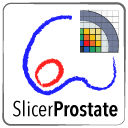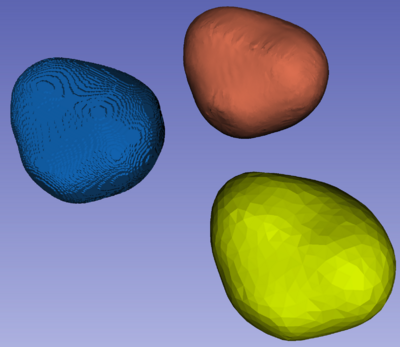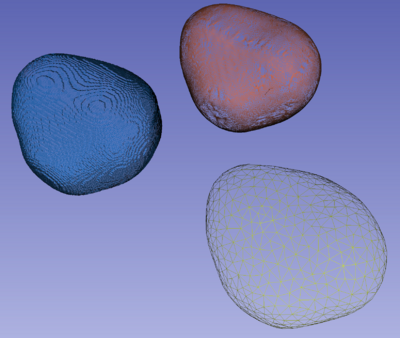Documentation/4.5/Modules/QuadEdgeSurfaceMesher
|
For the latest Slicer documentation, visit the read-the-docs. |
Introduction and Acknowledgements
|
Module Description
This module can be used as an alternative to ModelMaker to generate a smooth triangulated surface of a segmented label with improved (in the opinion of the author of this module) control over the number of triangles in the output surface, as well as improved visual appearance of the result. In the example below, the Marching Cubes output has 18750 triangles (blue), ModelMaker with 0.5 smoothing and 0.5 decimation generates 11173 triangles, (red) and the output of QuadEdgeSurfaceMesher (yellow) contains 1606 triangles. The result produced by ModelMaker with decimation setting set to 0.99 (a parameter similar to the decimation constant of the module being presented) produces triangulation that looks too embarrassing to show here.
This module was motivated by the need to generate smooth compact surface triangulations for prostate MRI images.
The module operates by applying Marching Cubes algorithm to the input segmentation, and then uses the ITK filters implementing the approach described in [1]. Currently, the module does not support multiple labels.
Use Cases
- MRI-ultrasound fusion biopsy of the prostate (primary)
- therapy planning
- treatment response assessment
Tutorials
None at this time ... stay tuned!
Panels and their use
- Input image: input segmentation image
- Label to mesh: label ID to use for triangulation
- Decimation constant: parameter that determines the number of the triangles in the output surface mesh as a proportion of the triangles in the mesh produced by marching cubes.
- Output triangulated surface: surface model that to store the result
Similar Modules
ModelMaker
References
[1] Gelas A, Gouaillard A, Megason S (2008) Surface meshes incremental decimation framework. Insight J http://www.insight-journal.org/browse/publication/298
[2] Fedorov A, Khallaghi S, Antonio Sánchez C, Lasso A, Fels S, Tuncali K, Neubauer Sugar E, Kapur T, Zhang C, Wells W, Nguyen PL, Abolmaesumi P, Tempany C. (2015) Open-source image registration for MRI–TRUS fusion-guided prostate interventions. Int J CARS: 1–10. Available: http://link.springer.com/article/10.1007/s11548-015-1180-7.
[3] Fedorov A, Nguyen PL, Tuncali K, Tempany C. (2015). Annotated MRI and ultrasound volume images of the prostate. Zenodo. http://doi.org/10.5281/zenodo.16396
Information for Developers





